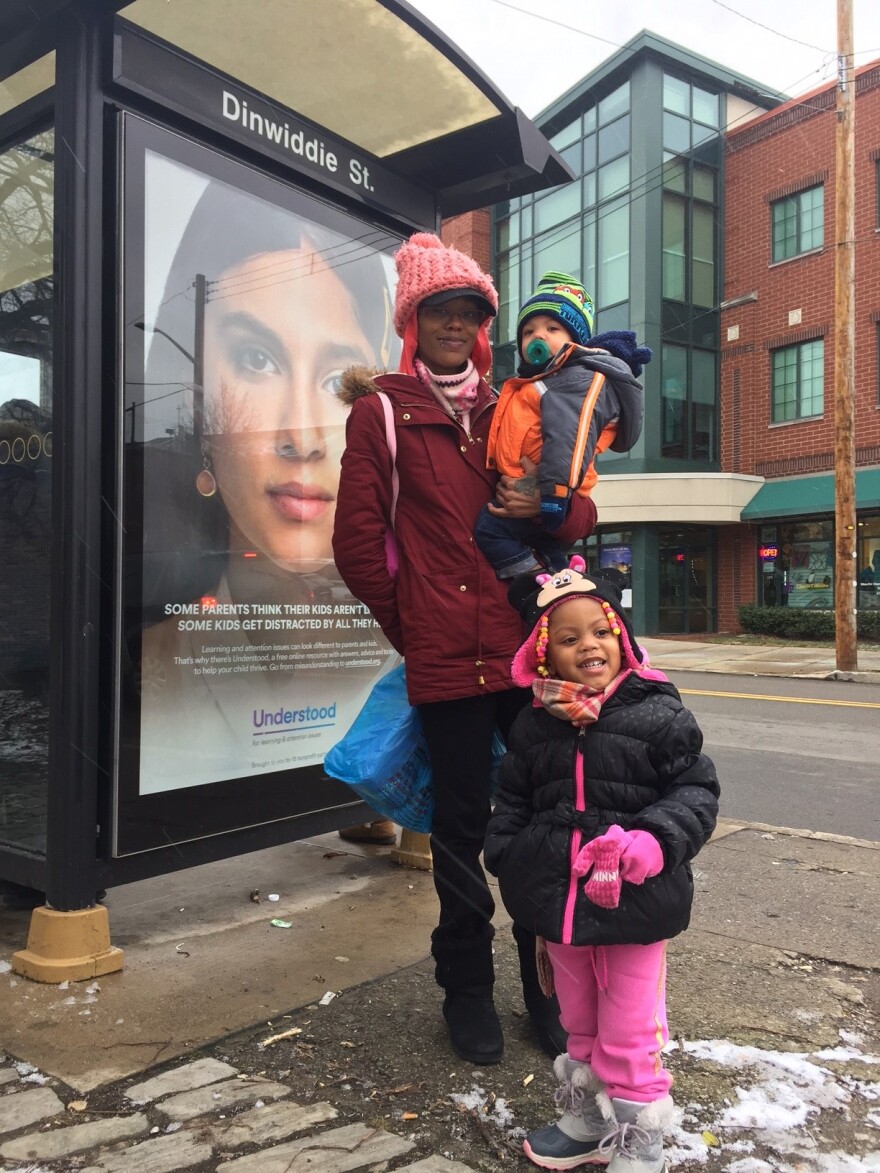On a snowy afternoon in the Hill District, Shafon Willis and her two kids waited for the 83 bus. Winter, 3, couldn’t seem to hold onto one of her pink gloves, which kept falling to the ground.
The Willis family rides the bus about three times a day to get to daycare and Shafon’s job on the South Side. She said she’s not a big fan of some of the recent changes to the bus system in Allegheny County. A new rule that went into effect Jan. 1 requires riders to enter in the front of the bus and exit from the back of the bus.
“We’re all compacted, and then you gotta get to the back door,” Willis said. “That’s what the big deal is for me with kids. I try to sit toward the back since I gotta get of the back anyway.”
Deborah Page is a senior and recently hurt her back, which makes exiting through the back door a problem for her, as well.
“Every time I try to get off at the back, it’s up so high, so I have to get off at the front,” she said.
Shalita Franklin, 69, of the Hill District said she doesn’t mind the change – in theory.

“I think it’s a nice change, but not everybody’s going by the rules,” she said. “Getting off on the back of the bus and getting off on the front, do you have an option to do that?”
Adam Brandolph, Allegheny County Port Authority Spokesman, said that is an option -- sort of. He said most of the initial complaints he’s heard are from people confused about those logistics.
“I think that really is a function of people did it the same way for so long,” he said.
He said bus drivers realized quickly that if someone is elderly, uses a mobility device or has a bike strapped to the front of the bus, it’s just common sense to let them off the front.
But the organization is still figuring out a formal policy.
Another change to the system incentivizes using ConnectCards rather than cash. Now, the base fare is $2.50 for those using the card. It’s $2.75 for those who use cash. There are no more paper transfers and no more paper tickets, which Brandolph said also caused a kink last month when some people had to go to customer service downtown to transfer the value of the paper tickets onto cards.
He said the Port Authority handed out a lot of ConnectCards. They’re available at the downtown service center, most Giant Eagles and at about 60 ticket vending machines throughout the county. The Port Authority also just partnered with Goodwill retail shops to put card machines there, too.
“We’re looking almost on a daily bases at places to add where folks can reload their cards,” Brandolph said.
Molly Nichols, director of the grassroots organization Pittsburghers for Public Transit, said that’s still not enough. Nichols said the changes make it difficult for someone who can’t easily add money to a ConnectCard.
“If you’re a rider and don’t have a credit card or bank account, you can’t do it online, you have to do it at vendor,” she said.
Nichols said even if people do get the card, they still have to pay $1 for a transfer. She said ideally, that would be free for everyone. Now, riders who pay cash and want to transfer have to pay the full $2.75 fare – twice.
But Brandolph said at least one-quarter of the county’s 100,000 daily riders will benefit from another recent change: the elimination of the Zone 2 fare. Now it costs the same to go across town or across the county. For decades, the Port Authority had multiple zones with modest fare increases over time, Brandolph said.
“Twenty-five cents here, 25 cents there,” he said. “It came a point where we could keep making gradual increases or we could make a more significant change to the way people ride.”
Nichols said her organization supported that change, because the Zone 2 fare was an especially high burden for low-income people living in the suburbs. According to the Department of Human Services, that population is increasing in the region. Nichols said that change was especially important for Mon Valley riders who go into the city for work.
Brandolph said the fare changes will cost the Port Authority about $4.5 million worth of revenue in a year, which he says is just about 1 percent of the agency's annual budget. But he said ridership has been fairly steady, no routes have been cut in years and he anticipates increased ridership with these changes.
“It’s reinvesting in our riders, reinvesting in our system,” he said. “Overall major policy change like this, we’re very comfortable reinvesting that money into the system.”
Nichols said for the most part, it’s been a fairly smooth transition, especially in terms of public education with actions like making announcements to bus riders.
“That was smart, you’re sitting there and you hear it,” she said. “I thought that campaign of painting the buses was really smart to help get the word out.”
She said the real test will be what happens next and hopes the Port Authority continues to increase ConnectCard locations and monitor accessibility. Though, she said any changes made to public transit should take everyone into consideration.
“It’s something we think is really worth paying attention to, to make sure it doesn’t disproportionately impact low-income communities and minority communities,” she said.




